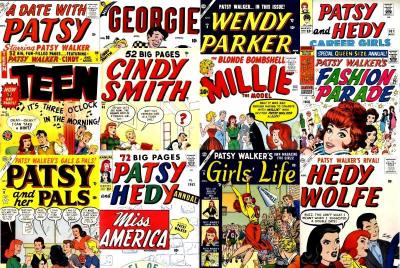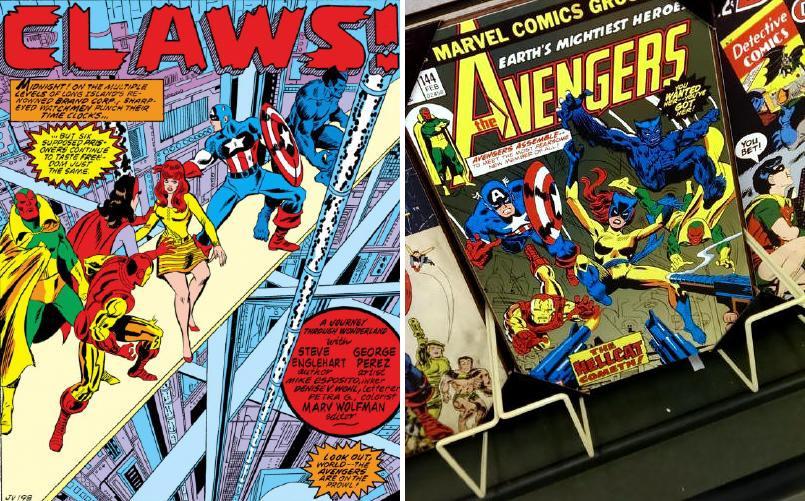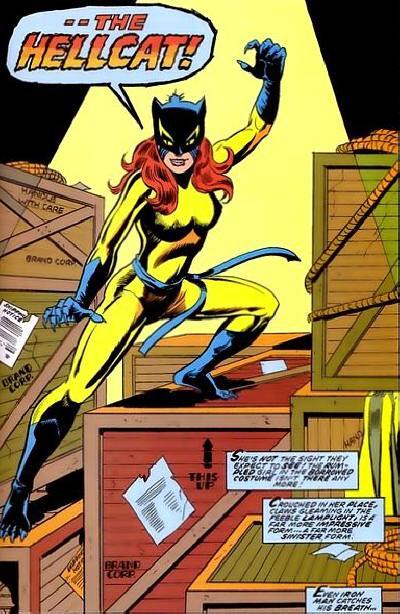The Marvel Super Heroes Podcast Episode 018

To permanently save this episode's MP3 file to your computer or other listening devices, right-click the link below to bring up sub-menu and select “Save Target/Link As...” Pick where you want it to save to, and you're set.
Look for us on iTunes, or just Download MP3

Note: We like our language NSFW salty, and there be spoilers here...
Face Front, True Believers! This week Illegal Machine, Mister Fixit, and Diabolu Frank explore arguably the most successful female protagonist of Marvel/Timely's Golden/"Middle" Ages, Patsy Walker! "The Girl Who Could Be You" starred in the comics section of Miss America: Teen-Life Magazine, whose 1946 covers boasted it as the largest selling teen-age magazine at "More than 1 MILLION COPIES" (emphasis theirs.) Within months of her 1944 debut, "The Prettiest Gal in Town" gained her own eponymous comic book series, which led to a slew of spin-offs across 23 years of continuous publication from the end of World War II through The Human Be-In. Patsy's only rival for the #1 lady of Timely/Atlas spot was Millie the Model (1945-1973,) and the only hero to lay such a claim was Kid Colt (1948-1979.) However, of the three only Patsy found a second life in the mainstream Marvel Universe proper (just five years after her series ended,) first as a supporting character to The Beast, then as the costumed heroine Hellcat. We trace her tortured, byzantine, fabulous path through publication lo these past seven decades! In fact, we were so irrepressibly ecstatic, we ran longer than any previous episode and posted two tumblr galleries, here and here!

Patsy (seated at center) and Pals (clockwise from left) Nancy, Hedy, Ronnie, Buzz and Tubbs.
How much was Patsy Walker influenced by Archie Andrews? The cover of Patsy Walker #7 even references a "Riverdale Charity Drive." It took a while to settle on her red hair though. She's a brunette on her first eponymous cover, then again for #9-13. She transitioned to auburn on #2-5, strawberry blond on #5-6, and blond on #7-8. Auburn returned from #14, with varying shades thereafter, and she didn't commit to being a proper ginger until 1950. A possible contributing factor was that her first regular gig was in Miss America Magazine, which routinely featured photo covers of blond and brunette young women. It was only after they switched to illustrated Patsy Walker covers that both series consistently featured her as a redhead. Even when they went back to photo covers, the models' hair shifted spectrum.

According to Marvel Masterworks Resource Page, the earliest Patsy Walker stories were "written by Stuart Little (the husband of 'Miss America's editor for volumes 1-4, Bessie Little)." Their message board has a post featuring sample scans from issues of Miss America Magazine you might like to give a look. It appears that the very first Patsy story page is offered, introducing Buzz Baxter and the Walker family featuring Stanley, Mary, & Mickey. In the postcast, we identified the mother as "Betty," though we don't know if that's an error or just another indication of inconsistency in the parents' names. Also notice a mention of shopping in Farmdale that makes us wonder if that was Walker's first hometown name or perhaps a neighbor city to Centerville. 1947's Miss America Magazine #37 was the first issue to feature Patsy Walker's name (in the form of her enduring logo) prominently as a sales draw, where it would remain for most of the rest of the run.

Comichron.com reports that in 1962 Patsy & Hedy ranked #45 in all comics sales for that year with an average reported sell through of 139,855 copies, marking it as Atlas/Marvel's #2 title behind Modeling with Millie's 143,476. Tales to Astonish, Strange Tales and Journey into Mystery were relatively close behind. The Fantastic Four, Incredible Hulk, Spider-Man, Thor and Ant-Man were all active that year, but the sales numbers for many of them are unknown in their early years. Comichron's 1963 rank saw Patsy Walker rise to #29 overall at 174,375 copies on average, though she fell in rank within the Marvel family behind Rawhide Kid, Kid Colt Outlaw, Tales to Astonish, Strange Tales, Tales of Suspense and Journey into Mystery as super-heroes like Iron Man, Human Torch, Wasp and the X-Men ascended, though Patsy did nudge Millie the Model out of the top girls' humor spot. Comichron 1964 is especially spotty in its reportage, as most super-hero titles remain absent. Strange Tales reported 215,090 for top spot of those listed. Not on the list was Patsy Walker, but our copy of #115 offers sales of 174,300, placing it in the top 50 of books with available numbers. 1965's Patsy Walker #120 listed average circulation of 195,000, though the issue nearest to filing date sold 211,400, likely due to the course change toward romantic drama. The similarly revised Patsy & Hedy: Career Girls #99 rose from an annual 199,765 to 229,400. That would place them in the bottom third of the top 100 per Comichron, and quite a bit lower than Millie the Model's 219,427. Patsy Walker was cancelled by 1966, though Patsy & Hedy: Career Girls #105 posted 199,826 average with a nearest issue surge to 245,175. Well within the top 100, it still wasn't enough to save the book from the ax in 1967.

The Patsy Walker Baxter Hellstrom Reading List (1944-1989)
- Miss America Magazine #2-83 (November 1944-March 1953) which was reprinted in Canada by Superior Publishers Limited
- Patsy Walker #1-124 (Summer 1945-December 1965) which was reprinted in Canada by Bell Features
- Georgie Comics #8 (November 1946)
- All Teen #20 #20 (January 1947)
- Teen Comics #21-35 (April 1947-May 1950)
- Cindy Comics #30, 34, 36 (August 1948, April & August 1949)
- Patsy and Hedy #1-110 (February 1952-February 1967)
- Patsy and Her Pals #1-29 (May 1953-August 1957)
- Wendy Parker Comics #1-8 (July 1953-July 1954)
- Girls' Life #1-6 (January 1954-November 1954)
- Hedy Wolfe #1 (August 1957)
- A Date With Patsy #1 (September 1957)
- Millie the Model Comics #103 (July 1961)
- Millie the Model Comics #107 (March 1962)
- Patsy and Hedy Annual #1 (1963)
- Fantastic Four Annual #3 (1965)
- Modeling with Millie #43 (November 1965)
- Patsy Walker's Fashion Parade #1 (1966)
- Amazing Adventures #13-15 (July-November 1972)
- The Avengers #139-144 (September 1975-February 1976)
- The Avengers #147-151 (May 1976-September 1976)
- The Defenders #44-57 (February 1977-March 1978)
- Spidey Super Stories #39 (March 1979)
- The Defenders #59-81 (May 1978-March 1980)
- The Defenders #83-101 (May 1980-November 1981)
- The Savage She-Hulk #12-14 (January-March 1981)
- Spidey Super Stories #53 (July 1981)
- The Defenders #103-104 (January-February 1982)
- Captain America #268 (April 1982)
- Fantastic Four Roast #1 (May 1982)
- The Defenders #106-111 (April-September 1982)
- The Defenders #116-122 (February-August 1983)
- The Defenders #125 (November 1983)
- The Defenders #148 (October 1985)
- The Incredible Hulk #277-279 (November 1982-January 1983)
- The West Coast Avengers Annual #1 (1986)
- West Coast Avengers #14-16 (November 1986-January 1987)
- Solo Avengers #9 (August 1988)
- The Avengers #305 (July 1989)
- Marvel Comics Presents #36 (December 1989)
- Avengers Spotlight #27 (Mid-December 1989)
Read Siskoid's take on RAMPAGING HULK #7, Marvel Comics, February 1978!
As you can tell, we love a fierce conversation and a pretty picture, so why don't you socialize with us, either by leaving a comment on this page or...
- Tweet us @rolledspine
- Email us at rolledspinepodcasts@gmail.com
- Roll through our tumblr
- If this blog won't let you comment, we've got a spare

If you think having the Patsy Walker comic book exist within the Marvel Universe is far out, contemplate Modeling with Millie #54 (where Millie, inspired by reading Fantastic Four #63, dreams of herself as the superheroine Millie the Marvel).
ReplyDelete